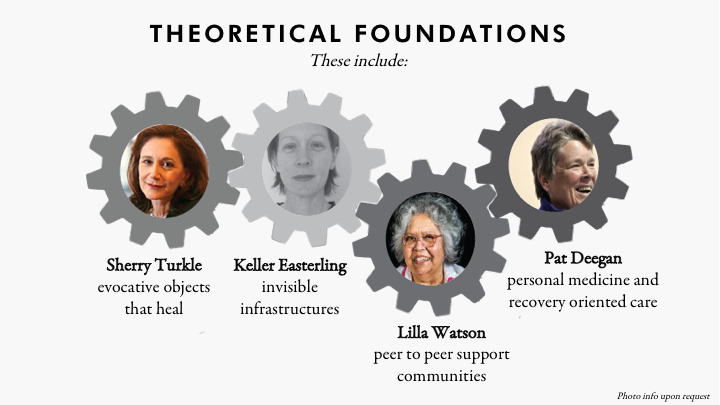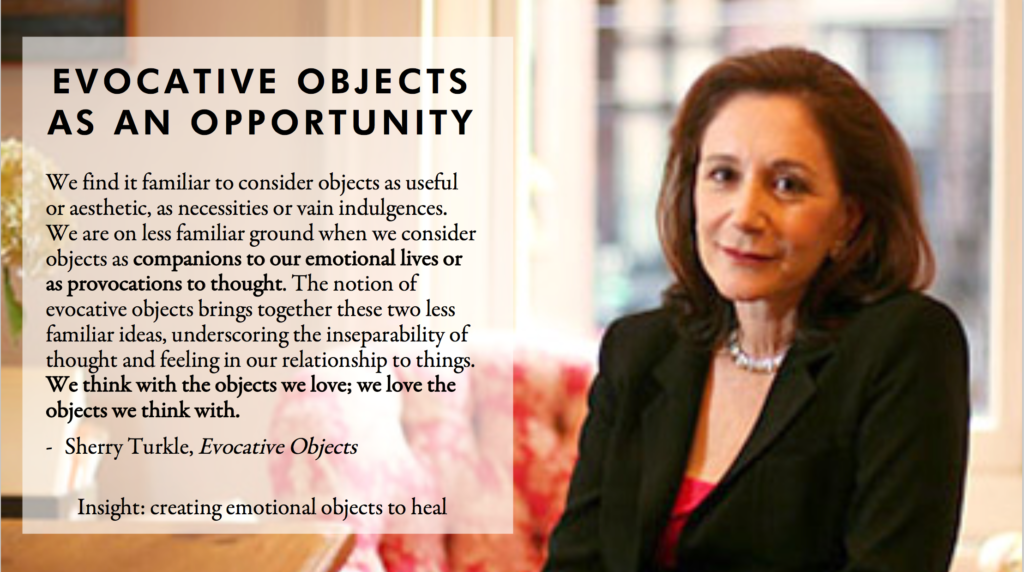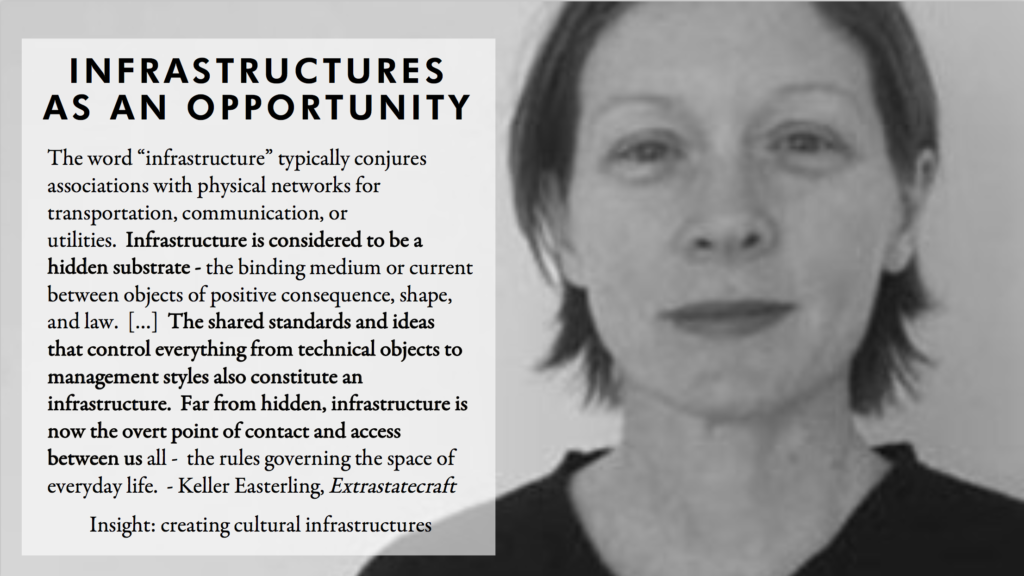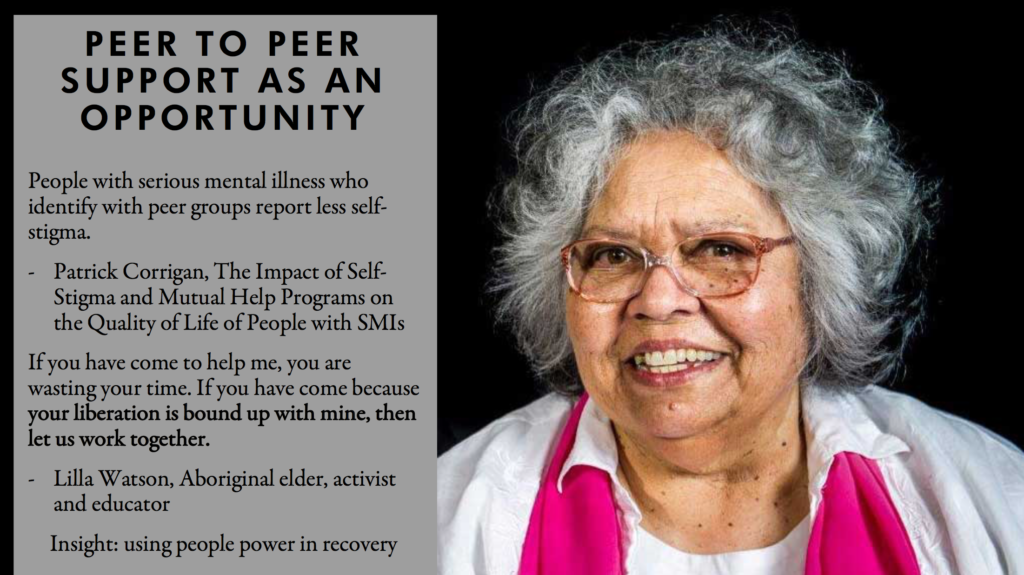Main theoretical foundations
On a simple level, my work revolves around recovery oriented medicine (described below), but as I am exploring the internal worlds around stigma I looked to cultural studies and other fields to see where a transdisciplinary approach would take me, and it this openness to multiple schools of thought and methodologies within disciplines that served as the main foundations for my work.

Evocative objects: can we use objects to heal?

The deceptively simple phrase ‘we think with the objects we love; we love the objects we think with’ lies at the heart of Sherry Turkle’s work in this anthology that focuses on ‘everyday riches’ – the objects in our lives that we hold a connection to in ways we may not know. People discussing objects that are meaningful that reveal intimate truths about their lives captivated me because it reveals emotion in a relationship to an object, and that object became a lever for people to think reflectively about their own lives. I wanted to incorporate the idea of this object as an interface to emotion and reflection – a way to help someone get into a certain reflective mindset for reframing negative thought patterns, and do so via an emotional bond with an object. On some level an illness is a trauma to a body; if violence like terrorism is an attack on the body politic, the concept of an illness is an attack on the personal politic. It may have perfectly normal biochemical rational behind it – a shortage of serotonin – but there is a deeper meaning to the concept of living with illness and how the experiences of living with such an illness can become a trauma to the self. Can objects help heal us from those traumas? Can we use objects to reframe questions about illness and stigma and aid in recovery? A key component to expand on here if we are to think of healing as a goal is the integration of more recovery-oriented therapeutic tools into the objects. When we speak of evocative objects, they can put people in a new mental framing, but whether that is a simple ‘talisman’ that represents a greater system for the framing, or a more detailed object of use where deeper interaction and content is added remains to be explored. The exploration of creating talismans in a secular context in a highly technically mediated age is an area of possibility worth exploring, let alone the infrastructure to build such items. This theory influenced the outcome of the project by making the use of objects central to designing the system, and as serving for the basis for the prototyping.
Invisible infrastructures – can we consciously create cultural infrastructures?

Keller Easterling’s work reframed my thinking of infrastructures completely. We know of physical infrastructures, invisible infrastructures (especially now of data) and cultural and organizational infrastructures like the World Trade Organization that operate as ‘extrastatecraft’ in our lives, often unelected or even visible, but still profound in how they influence our lives. It is in when these areas blur – such as the Free Trade Zone or the Temporary Autonomous Zone’ – that life becomes complicated but also a place of possibility. The concept of infrastructure as a ‘point of contact’ shapes how design interventions can work; a ‘current between objects’, too, that bind the objects into a system is a foundation for my work as I explore how different interventions could conceivably work together. Something from Easterling’s work that resonates is the idea of infrastructure as layers in the world – something Benjamin Bratton’s work in The Stack certainly focuses on. If we see a dramatic need to reduce the stigma around mental illness, can we create a layer of culture to aid in this work? Is it possible to create a positive cultural infrastructure in response to the negativity that predominates so much of our conceptions of mental illness? The challenges in setting out to ‘design’ a culture is that so much of cultural expressions is organic, often seizing upon a set of circumstances rather than a set ‘program’ of creating a culture. At the same time, perhaps we can successfully and consciously create a new culture in response to narratives of a dominant existing culture that so often portrays mental illness negatively. In this sense creating an infrastructure utilizing objects and rituals/activities in particular may help to create that culture. This theory influenced the outcome of the project by incorporating a new kind of infrastructure as a foundation in my work.
Participatory civics culture: can we create a more participatory, political dimension to how we live with illness?
How may more traditional organizations adopt and learn from the successful practices of participatory civics culture (PCC) organizations? Our analysis suggests that young people engage and mobilize when they can link civic activities to other interests. Returning to our three components of experience, the links forged between traditionally accepted civic goals (“wish to help”) and experiences more closely associated with participatory culture (“shared media experiences” and “sense of community”) provide important insights into how PCC organizations mobilize youth to care about, and take action around civic issues. The civic practices we identify become opportunities for civic learning. They also clearly point to the central role that media, especially new media, plays in these contexts. […] More traditional organizations may look to these practices and structures as tools to engage youth in ways that genuinely value their interests, their communities, and their participation.
The stigma around mental illness creates a culture that keeps people with a mental illness often isolated without people to speak to, and that isolation means that people can become disconnected from others at the very moment when they would most be benefiting from speaking with a peer and engaging in activities that shed a new light on the possibilities of living with illness. Additionally, the work of fighting stigma against mental illness may not be seen as something to be address by those who live with mental illness – and this lack of political action keeps the cycle of silence that keeps stigma in power unchecked. There is an opportunity for peer support groups (discussed below) to create a participatory civics culture around mental illness through collective numbers – to combine participatory culture and civic engagement with emotional support and activities that support organized collective action towards civic goals like ending stigma. The work of Neta Kligler-Vilenchik and Sangita Shresthova has studied participatory civics cultures, and have identified a set of interlocking principles that help build such a culture. Such principles have been identified by Henry Jenkins as addressing creative activities, informing activities, connecting activities, organizing and mobilization activities. For the ‘creating’ cluster, the focus is on community building, storytelling and media production; for the ‘informing’ cluster, spreading the word (user stories) and learning about the issues is the focus, with the ‘connecting’ cluster (connecting within group and with other groups) and ‘organization and mobilization’ clusters rounding out his model. Such work is important to understand how to sustain the work of the participatory civics community so that it can deliver its work despite small numbers and limited financial resources. This theory influenced the outcome of the project by focusing on the activities central to the Lighthouse community, and seeks to advocate for participatory civic cultures as a way to create bonds among peers that go beyond emotional support to actively build a movement committed to creating positive narratives around mental illness. This especially is integrated in the kinds of rituals/activities suggested in the Lighthouse methodology and help to create a collective spirit of action and solidarity around challenging the stigma around mental illness – something no person should have to do alone.
Peer to peer support: can we harness the experience of others to manage our illness?

Peer to peer support honors lived experiences of those with mental illness and believes it benefit others to share experiences. There are lessons that can be shared by those who’ve experienced to those who have little knowledge about mental illness, and while mental health professionals do their best to create conditions for trust, there can still be shame discussing illness, side effects and the shame they may experience through discrimination and ignorance. Peer to peer support has been well studied and has been shown to be effective; the challenge is that such efforts are not comprehensively integrated as part of treatment plans created by mental health professionals, and in an individualized culture like the U.S., consumers may feel that they can only deal with illness on their own. The onus is on mental health consumers to know where to look for support groups; at the same time, most peer support groups lack organizational infrastructure for outreach or trained and paid staff. Peer to peer support focuses often on emotional support with some knowledge sharing (sharing doctor recommendations, for example), but often fails to build a community through socialization, shared interests or activism that is central to participatory civics cultures. I seek to advocate for peers as part of treatment, especially earlier upstream. This theory influenced the outcome of the project by focusing on the roles and activities central peers play in a possible intervention.
Recovery oriented systems of care: can we shift our frameworks of how we view and treat illness?
The view of illness in a recovery oriented system of care is a shift from traditional healthcare’s focus on treatment of illness to eradicate it. Recovery views a person through a holistic lens outside of the illness to understand the unique circumstances. This framework incorporates a core set of values that include multiple pathways to recovery, addresses the cultural dimensions that shape illness, and views recovery exists on a continuum of improved health and wellness. There is a body of evidence to support both recovery oriented systems of care and peer to peer support; the challenge is that while many states have adopted this shift, the reality is more uneven in how well a shift has actually happened in culture. The federal government’s Department of Health and Human Services’ SAMHSA (the Substance Abuse and Mental Health Services Administration) branch focuses on improving quality and availability of treatment for substance abuse and mental illness, but operationalizing this as a best practice across all states presents a challenge in a decentralized political context where state standards and ‘state’s rights’ often supersede federal authority. The difficulties in implementation may also be embedded in our culture of care itself. The organizational resistance to changing the view of illness and recovery – and who delivers it, in the case peer and peer and consumer empowerment – is something advocates like NYAPRS (New York Association of Psychiatric Rehabilitation Services) have identified. Their work has identified factors that stand in the way of adoption of recovery as best practice– including that power sharing is not always comfortable for staff. My work seeks to incorporate the content from this framework in recognition of the benefits both it and peer to peer support play in helping those with a mental illness. Since self-stigma is such a unique and personal experience, the theoretical foundations we use to address it should be open and customizable to meet the needs of the people within it. This theory influenced the outcome of the project by creating a more solid, proven theoretical framework to shape the content of the prototypes.
Self-stigma: using design build on the work of Graham Thornicroft?
The final main theoretical foundation of my work is from Graham Thornicroft’s research on self-stigma, which identified a few key areas where successful initiatives have made a difference in helping people reframe negative narratives and rethinking the possibilities of their future. These areas include psycho-education (learning about what a disease is, its symptoms, treatment, prognosis, etc.), medication non-adherence (where someone with a mental illness stops taking medication, thus potentially triggering a mental health crisis moment such as a psychotic episode), relapse prevention (best practices for managing illness that include exercise, sleep, proper diet, stress reduction techniques etc.) and coping skills training (cognitive behavior therapy and other ways to identify and learn healthy ways to cope and reframe negative thinking patterns). This theory influenced the outcome of the project by helping to identify what areas to focus on for prototypes.
The future of medicine
Finally, a last major consideration for my foundation was the larger ecosystem of how healthcare is changing – what Leroy Hood has termed ‘the four Ps of P4 medicine‘, or systems medicine:
- Predictive: In 10 years we’ll all have our genomes as part of our medical record. This will tell us what disease we are at risk of and offer specific advice on how to optimise wellness.
- Preventative: With this type of medicine, the mysteries of the immune system will be solved so that vaccines for conditions such as AIDS and Malaria can be created. It will also refocus medicine on the future rather than the present so that patients are constantly thinking about their overall wellness.
- Personalised: We are all genetically different and therefore should be considered as genetically unique and not as a statistical average. It means we should be responsible for being in control of our transition from health to disease.
- Participatory: This raises questions of how to convince physicians that this revolution in medicine is something they can adopt, how to educate patients about the opportunities, challenges and responsibilities of adopting this medicine and how to change the mindset of the entire medical community. (Alice Haine, The National)
While it may be impossible for any one intervention to address all three, by the end of my thesis I felt that I was addressing the preventative, participatory and on some level personalized aspects of the future of medicine, an important consideration for my work.
